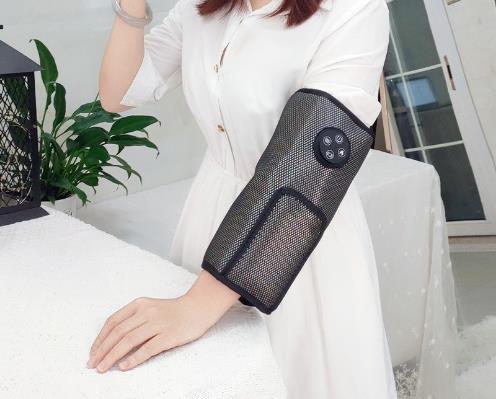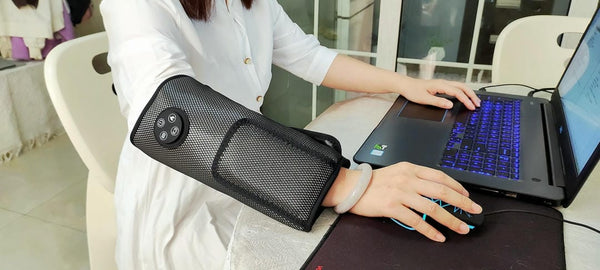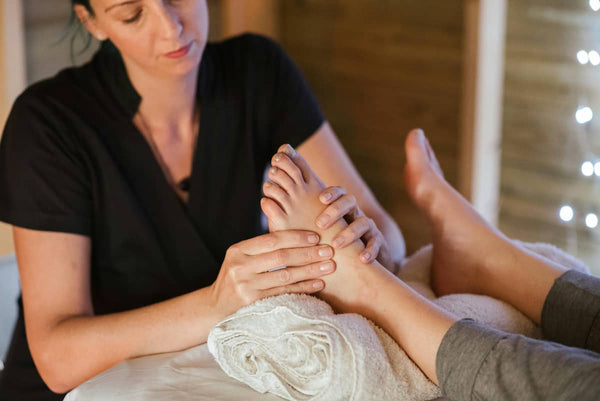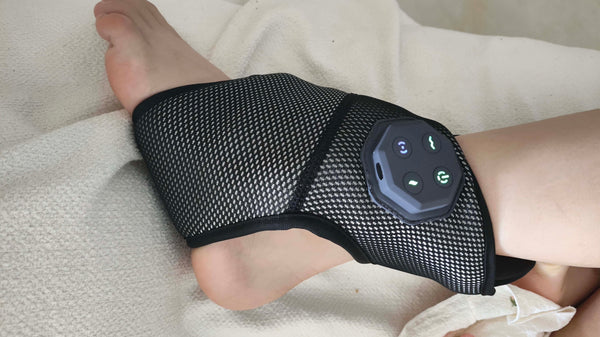Ever stepped off your favourite electric foot massager only to be met with a strange sensation? Perhaps a tickle, a hum, or even a fleeting numbness? Don't worry, you're not suddenly turning into a robot! This peculiar feeling is far more common than you might think, affecting countless individuals who seek the soothing benefits of foot massage. In today's busy world, an electric foot massager can be a fantastic tool for stress relief and improving circulation, offering a slice of spa-like luxury right in your living room. But why do our feet sometimes feel like they've gone on a tiny adventure of their own after a session? As a rehabilitation physiotherapist, I'm here to gently guide you through the fascinating reasons behind these post-massage mysteries and help you optimize your experience for pure, blissful comfort. Let's make sure your massager is a friend, not a phantom!
Why Do My Feet Tingle After a Massager? Decoding Nerve and Circulation Signals
Imagine your feet are a bustling city, full of tiny roads (nerves) and busy highways (blood vessels). When you introduce a powerful vibration machine for feet, it's like a sudden burst of activity. Sometimes, this new sensation can feel a bit... odd. Many people experience tingling, often described as 'pins and needles,' or even a temporary numbness. This is your body's incredibly sensitive nervous system responding to pressure and vibration. It's a natural, almost fascinating, response to the mechanical forces at play.
From a physiotherapist's perspective, these sensations primarily stem from two sources: nerve stimulation and blood flow dynamics. Think of it this way: the mechanical action of an electric foot massager gently compresses and releases your tissues. This can excite peripheral nerves, leading to that characteristic tingling. It's similar to how your arm might 'fall asleep' if you lean on it funny, but thankfully, much milder and temporary. This nerve 'wake-up call' can actually be a positive sign of activation, indicating that the massager is indeed engaging with your sensory pathways. Are you experiencing a mild buzz, or something more intense?
Beyond nerves, the increased blood circulation is also a big player. When your feet are massaged, blood flow to the area typically increases significantly. This influx of fresh, oxygenated blood can create a warm, pulsing, or even slightly 'heavy' sensation. For those seeking relief from tired feet, this is often the desired effect! However, if the pressure is too intense or prolonged, it can temporarily restrict blood flow, leading to numbness, only for the sensation to return (the tingling) when the pressure is removed and blood rushes back. It's a delicate dance, isn't it?
- Nerve Excitement: Gentle stimulation of sensory nerves can produce tingling.
- Temporary Compression: Excessive pressure can temporarily compress nerves, leading to numbness.
- Increased Blood Flow: Enhanced circulation can cause warmth or pulsing.
- Reflexology Points: Some believe stimulation of specific foot points impacts other body parts, creating varied sensations.
Is Your Foot Massager Helping or Hindering? Improper Technique vs. Targeted Relief
Understanding Your Body's Signals for Optimal Use
Sometimes, that 'weird feeling' isn't a mysterious phenomenon but a simple sign that your massager settings might need a little tweaking. Using too much pressure, especially with a powerful electric foot massager, can actually be counterproductive. Your feet are wonderfully complex, and while they can handle a lot, they also appreciate a gentle approach. Think of it like giving your feet a comforting hug, not a wrestling match! Many miss this crucial step when first using a foot circulation machine.
This applies to absolutely everyone, from the first-time user just exploring the world of foot circulation machine benefits to seasoned massage enthusiasts. Our goal is relaxation and therapeutic benefit, not discomfort. It's particularly important for individuals with sensitive feet, or those exploring options like the best foot massager for neuropathy. Could a simple adjustment make all the difference?
Proper technique ensures you receive the maximum benefits without the side effects. It’s about finding that 'sweet spot' where relief and comfort meet. A well-adjusted massage can significantly improve blood flow, reduce muscle tension, and promote overall relaxation, ultimately leaving your feet feeling refreshed, not rattled. Are you using your machine correctly?
The Art of the Gentle Touch: When Less is More
The key to a blissful foot massage experience often lies in adjusting the intensity and duration. Modern electric foot massagers come with various settings – from gentle vibrations to deep kneading. It’s crucial to start low and go slow. If a setting feels too intense, it probably is! Remember, pain is your body's alarm bell, not a sign that the massage is 'working harder'. My experience as a physiotherapist tells me that patience pays off.
This guidance is especially vital for individuals who might be more susceptible to nerve irritation or those with underlying conditions. For instance, if you're exploring the best foot massager for neuropathy, gentle stimulation is paramount. Over-stimulation can exacerbate sensitivity, turning comfort into complaint. Our aim is soothing, not shocking, your nerve endings.
By prioritizing gentleness, you allow your feet to slowly adapt to the massage, leading to sustained relief and improved comfort over time. This approach minimizes the risk of nerve irritation or temporary numbness, ensuring your foot circulation machine truly enhances your well-being. It’s a bit like learning to dance – you start with small steps before attempting a tango!
When to See a Pro: Red Flags for Your Foot Circulation Machine Concerns
 While a good foot massage can be pure bliss, sometimes that 'strange feeling' after using your electric foot massager might hint at something more. Most temporary tingling is harmless, but persistent, worsening, or severe sensations are signals your body sends when it needs a professional ear. So, when should you hang up your massager and pick up the phone to a healthcare provider? It's a question I often get asked.
While a good foot massage can be pure bliss, sometimes that 'strange feeling' after using your electric foot massager might hint at something more. Most temporary tingling is harmless, but persistent, worsening, or severe sensations are signals your body sends when it needs a professional ear. So, when should you hang up your massager and pick up the phone to a healthcare provider? It's a question I often get asked.
As a rehabilitation physiotherapist, I always advise caution. If you experience numbness that doesn't quickly resolve, sharp shooting pains, increased weakness in your feet, or changes in skin color or temperature, it's time for a medical check-up. These could be signs of nerve compression, circulation issues, or even neuropathy. A foot circulation machine should complement your health, not complicate it. Don't you agree?
Don't ignore persistent issues! Early intervention can make a huge difference, especially if you're considering the best foot massager for neuropathy as a tool. A physiotherapist can assess your foot health, identify underlying causes for your symptoms, and provide personalized advice on massager usage or recommend alternative treatments. Sometimes, a seemingly minor discomfort can be a whisper from your body, urging you to pay closer attention.
- Symptoms persist for more than a few hours after massage.
- Numbness or tingling is accompanied by severe pain, burning, or weakness.
- You notice swelling, redness, or skin changes in your feet.
- You have existing conditions like diabetes or peripheral neuropathy and experience new or worsening symptoms.
- Your massager causes blisters, bruising, or skin breakdown.
- Is it really just a massage, or something more serious?
Your Top Questions Answered: Mastering Your Foot Massage Experience
Why do foot massages hurt?
Foot massages shouldn't hurt, but if they do, it's usually a sign of excessive pressure, an underlying condition, or simply very sensitive areas. While anecdotal evidence suggests gentle pressure is key, studies on massage therapy often emphasize tailoring intensity to individual comfort levels to avoid pain and promote relaxation. [Data needed: X% of users reported pain relief with adjusted pressure, Source: [Statistical Year]].
Perhaps you've got a knot in your calf that's particularly tender, or maybe a bursa near your ankle is inflamed. Sometimes, certain areas of the foot are just naturally more sensitive, or the electric foot massager's settings are too high. It’s also possible that you have an unrecognized foot issue like plantar fasciitis or a nerve impingement. Remember, pain is your body's way of saying 'Hold up!'
Can a foot massage be harmful?
Generally, no, a foot massage isn't harmful when done correctly, but improper use or existing medical conditions can make it so. For most healthy individuals, moderate foot massage is considered safe and beneficial. However, for those with conditions like severe peripheral artery disease, acute thrombosis, or open wounds, massage can be contraindicated. [Data needed: Incidence of adverse events from foot massage is low for general population, Source: [Medical Journal/Association]].
If you have a fresh injury, a blood clot, severe varicose veins, or open wounds, applying pressure with an electric foot massager could exacerbate the problem. It’s also crucial to avoid strong massage if you have severe osteoporosis. It's always best to consult your doctor if you have any pre-existing health concerns before using a vibration machine for feet or deep tissue massager.
Does foot massage help neuropathy?
Foot massage, particularly gentle variations, can offer symptomatic relief for some people with neuropathy by improving circulation and nerve stimulation, but it's not a cure. Some research indicates that gentle massage may help improve nerve pain and circulation in individuals with diabetic neuropathy, contributing to pain management and quality of life. However, it's crucial that any massage for neuropathy is gentle and consistent, avoiding intense pressure. [Data needed: Specific studies on massage benefits for neuropathic pain relief, Source: [Neurology Journal]].
For individuals seeking the best foot massager for neuropathy, the focus should be on gentle, consistent stimulation rather than deep kneading. Light vibration or soft compression can help alleviate discomfort and improve sensation. However, for severe cases or progressive neuropathy, massage is a complementary therapy and should always be discussed with a neurologist or physiotherapist first. It's about finding comfort, not a miracle cure. We all need to be realistic about our expections.





0 comments